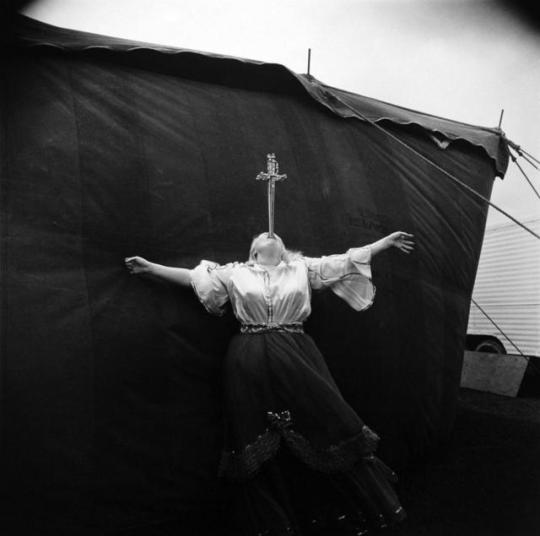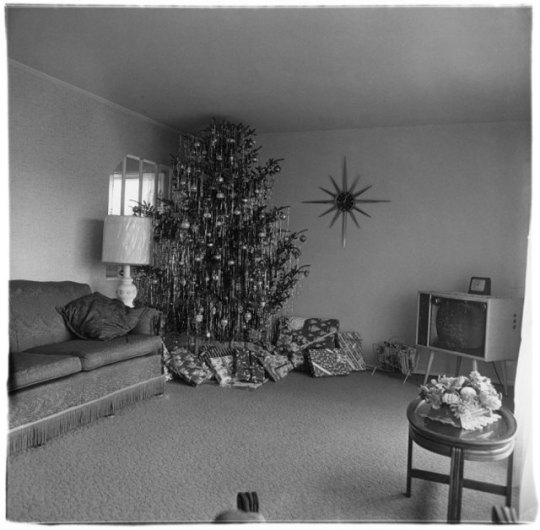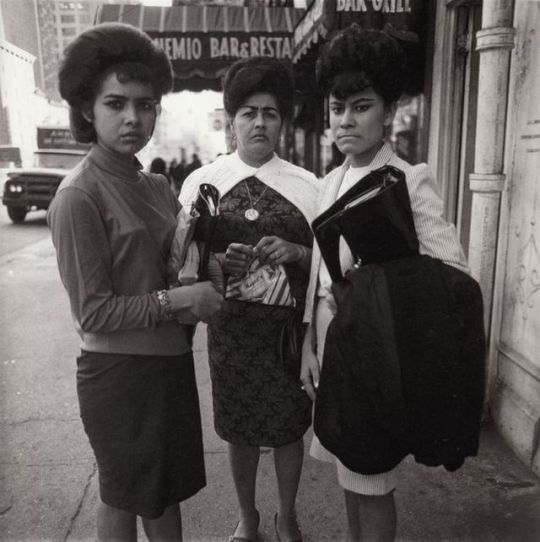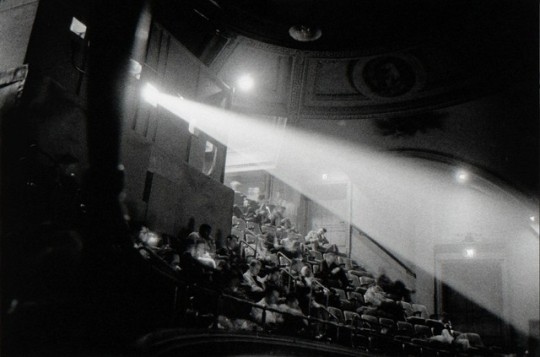My name is Cliff Seeger. I'm a film and photography student. I like story telling in any medium I can experience or create it. I use films and photos to express myself, although at times I don't really know what I'm trying to say. Oh, also I like green.
Don't wanna be here? Send us removal request.
Text
Diane Arbus: The Empathy of Art
When I first became interested in photography, Diane Arbus was already an artist that I had admired. During my first couple years of high school I became interested in films and filmmaking. I didn’t really know how to learn about films at that age so I just watched as many films as I could. One of films was Manhattan by Woody Allen. There’s a scene in which he, Diane Keaton, and their respective dates are at an art gallery and are talking about a photography gallery that is downstairs. Keaton’s character Mary remarks that the whole gallery “was all derivative of Diane Arbus without any of the wit.” I obviously didn’t know what that meant at the time, so I paused the movie to see who this Arbus was. I instantly knew what she was talking about; it just clicked. The name has stayed with me for years and I imagine it will stay there.
Diane Arbus came from reasonably comfortable roots. She was born in 1923 to a Jewish couple that owned a successful department store, “Russek’s”, in New York City. This made her somewhat sequestered of the effects on America during The Great Depression of the 1930s. By the time she was 18, she married her childhood sweetheart, Allan Arbus. They both had interest in photographers and photography and began a photography business in Manhattan in 1946, often being employed to take photos of the store and products of “Russek’s”, Diane’s father’s department store. Arbus worked as a commercial photographer until 1956, and although her commercial work is certainly notable, it isn’t quite what she was remembered for and why she has such a legacy of both fame and infamy. After her commercial work, she started to go on more personal endeavors into photography. She was most known for taking photographs of less than exposed, undermined, unrepresented, or underappreciated members of America, and even just humanity. People like dwarves, midgets, transvestites, strippers, nudists, etc. However, to simply label her as a photographer of just “freaks” would be a disservice to her. Above all else she was a humanist photographer. Taking photos not only of the people but of human emotions and feelings in things that weren’t of the people themselves. She would be very intimate with her subjects, really getting to know them, often times revisiting them after years to take their photos again. She would go into their homes and capture them in their living rooms or on their beds, or perhaps at their jobs. She would even strip naked with the nudists when she photographed them. Arbus was able to capture true empathy in the camera because she had true empathy without it. Her first major exhibition that gave her a lot of recognition was an exhibit called “New Documents”. It was an exhibit in the Museum of Modern Art that was, as described by John Szarkowski, curator for MoMA, “a new generation of documentary photographers”. It showcased the works of Lee Friedlander, Garry Winogrand, and of course Diane Arbus. The exhibit was described as “photography that emphasized the pathos and conflicts of modern life presented without editorializing or sentimentalizing but with a critical, observant eye.” However, Arbus faced many depressive episodes and took her own life by ingesting barbiturates and slashing her wrists on July 26th, 1971. The collection of her work she still owned was inherited by her eldest daughter, Doon, which she put on display in Venice Biennale and then later as a posthumous retrospective at MoMA, slightly over a year after Arbus’ death.
Arbus’ body of work is probably more influential to me than that of any singular photographer or artist that I admire. Not only is it bold but above all else it’s respectful and it’s empathetic. She doesn’t hold a candle up to these people as if to say “look at them and laugh”, but as if to say “here we are”. There isn’t a drop of ill intent in her work and that is what documentary work is all about: documenting the world as it is without an agenda. Most of her photos are square, which is due to her taking photos with a Rolleiflex or Mamiya C33 at waist level. The square format is really interesting since it eliminates the concepts of landscapes or verticals. It is as freeing a format as it is limiting when all four borders of your frame are equidistant. Aesthetically speaking, her photos are as brash and in-your-face as her subject matter, which is said as a compliment. She gives a lot of the “freaks” she takes photos of a very harsh and dramatic lighting, even going so far as to use flash photography during daylight in order to capture this surreal quality in many of her portraits. That level of empathy that she has in her photographs has always stayed with me and is what I try to emulate and channel when taking my own photographs. In conclusion, I will include and talk about 10 of her images that vary from many of her series and years of her work to show the diversity in her style as well as how prolific of a photographer she was.
1. Albino Sword Swallower at a Carnival, MA 1970
A very formal photograph but the most interesting part to me was the background. The tent in the background is this structure that isn’t that large but still towering over her. You still see the scope of the tent because Arbus shows the top. It would’ve been a completely different photograph if she just shot the sword swallower dead-on or adjusted it so only the tent was in her viewfinder as nothing more than a backdrop. It would lose something there. There are so many different levels of contrast here with the large white truck and/or sky behind her being this bright white but the tent being so dark and then again with the swallower’s skin and the tent, and yet again a third time with her blouse and her skirt. It all works so evenly together contrast wise. However, we can’t forget the swallower herself, the subject of the frame. It evokes, to me, a very biblical feeling with the hilt of the sword and the posture of her in that of a crucifix. Also how the back of her knuckles hit the back of the tent which makes it cave in slightly creating this haunting effect as if she’s striking the canvas as she makes this pose of “ta-da”.
2. Child with a Toy Hand Grenade in Central Park, NYC, 1962
This is probably one of the most famous pictures Arbus has done. It depicts this boy: in one hand he has a grenade, and his other hand is a sort of clawing grasp. But perhaps the most notable thing is the strap of his overalls is folded over on the same hand that looks like a claw. His expression and his posture both give this feeling of exploding apart from the grenade in his hand. He feels like he’s bursting at the seams. The contrast of this one is also a lot lower than what she usually does; it’s great how the shadows of the trees lightly paint the ground of the park around him.
3. Christmas Tree in a Living Room in Levittown, Long Island, NY, 1963
This one I find interesting for a whole different reason. This completely pristine living room without any blemishes to speak of and in the center is this Christmas tree completely draped in tinsel and decorations. It’s the only thing decorated in the room, and what I could only assume also the whole house, and it’s squeezed into that corner even though there is what appears to be a window to the right of the frame where the light is coming in, a usual spot to display your tree from the inside out. It isn’t quite trapped in the corner but it isn’t exactly allowed to breathe either. The second part that interests me about it is the location the actual photograph was taken, Levittown. Levittown, NY, and a few others, were the first ever mass produced suburbs in America post World War II and became a turning point in American living and real estate. For the first time ever people had these affordable suburb homes en masse. Within the course of a year or two entire towns were built out of nothing and made into whole communities but each of these houses sort of lacked a sense of identity. They were nearly all identical architecturally and I find it interesting to wonder what the neighbors of this home looked like and I imagine how similar it’d be.
4. Girl in a Shiny Dress, NY, 1967
The girl isn’t quite bashful but she isn’t quite courageous either. From her posture to the look on her face and the way her dress hangs from her body, it all just feels so uncomfortable. Her smile is very put on but it’s as if she forgot to tell her eyes and the rest of her face to try and look happy as well. The flash really helps illuminate her dress to show the textures and they really are quite stunning. It’s hard to imagine her in any other state other than being frazzled the way she is.
5. Two Ladies at the Automat, NY, 1966
In addition to the freaks she regularly took photos of, there are a number of portraits Arbus took of aristocratic women, and sometimes men, of the time. Visually there is such a stark difference between two women like this and the Albino sword swallower, for example, but I believe Arbus found some similarities between the two social groups. In a quote Arbus says, “Most people go through life dreading they'll have a traumatic experience. Freaks were born with their trauma. They've already passed their test in life. They're aristocrats." As for the actual photo’s aesthetic, again we can see the high contrast in the clothes between the two women, not just in tone but in pattern was well. Their expressions are what I can only describe as “blissful befuddlement”. With their sculpted or painted on eyebrows and their emotionless eyes, I can’t really tell what they are feeling and how they feel about their picture being taken. It has a remarkably eerie quality to it.
6. Lady Bartender at Home with a Souvenir Dog, New Orleans, 1964
This is one of the few photos of Arbus where it feels like genuine comedy with very little restlessness. Although she’s sitting slightly uncomfortably with her hand and a very odd position, the comparison of the toy dog and her hair is just too perfect. You can’t help but chuckle, even if only slightly, upon seeing it.
7. A castle in Disneyland, CA, 1962
If ever there was an artist that could make a Disneyland fairytale-esque castle appear to be something out of a Nosferatu, it would be Diane Arbus. The photo is genuinely creepy in all aspects. It feels like it’s towering over you, the light shining up on the towers, and the sense of some sort of fog surrounding the castle. The only thing that breaks that eeriness is the swan swimming through the mote. It changes the mood from flat-out creepy to something more serene, while still giving you a sense of being uncomfortable or perhaps even a slight sense of danger.
8. Female Impersonator in bed, NY, 1960
This was one of many transvestites, strippers, hermaphrodites, or any other adult performers. To me this photo is another great example of Arbus’ empathy. She isn’t trying to exploit this person but to share a small moment. There is nothing provocative or sensational about this photograph. To me she is just day dreaming and longing for something better. It feels like real innocence.
9. Three Puerto Rican Ladies, NY, 1963
Arbus took a lot of photos of people in groups of twos and threes, often times showcasing either the similarities or differences between them. This I find to be a medium between the two. Obviously their hair is the same and so are their scowls, but their age and dress differ quite a bit. They are all looking at Arbus as if she’s some car wreck they all just witnessed. The girl on the left seems like a teenager, the girl on the right seems to be in her twenties or so, and the woman in the middle seems to be about in her forties. Also, the items they are all carrying have very interesting qualities. Two binders, some books, a sports jacket, and a paper bag from what looks like could be from either a bookstore or a bakery.
10. 42nd Street Movie Theater Audience, NY, 1958
To end it I will talk about one of the most personal photographs to me. Few photos fill me with such elated joy as this one does. I have an incredibly romantic view of cinema, and this photograph gives me such a specific feeling. I feel sorry for anyone who looks at this photo and doesn’t get a sense of nostalgia and comfort, just thinking of the countless times going into a dark theater. It’s fantastic how the light from the projector just shoots through the frame with this overpowering beam, in this smoky, elegant theater.
0 notes
Photo










1. Albino Sword Swallower at a Carnival, MA, 1970
2. Child with a toy hand grenade in central park n.y.c. 1962
3. Christmas Tree in a Living Room in Levittown, NY, 1963
4. Girl in a shiny dress, NY, 1967
5. Two ladies at the automat, NY, 1966
6. Lady Bartender at Home with a Souvenir Dog, New Orleans, 1964
7. A castle in Disneyland, CA 1962
8. Female Impersonator in bed, NY, 1960
9. Three Puerto Rican Ladies, NY, 1963
10. 42nd Street Movie Theater Audience NY 1958 ALL PHOTOS BY DIANE ARBUS
0 notes


